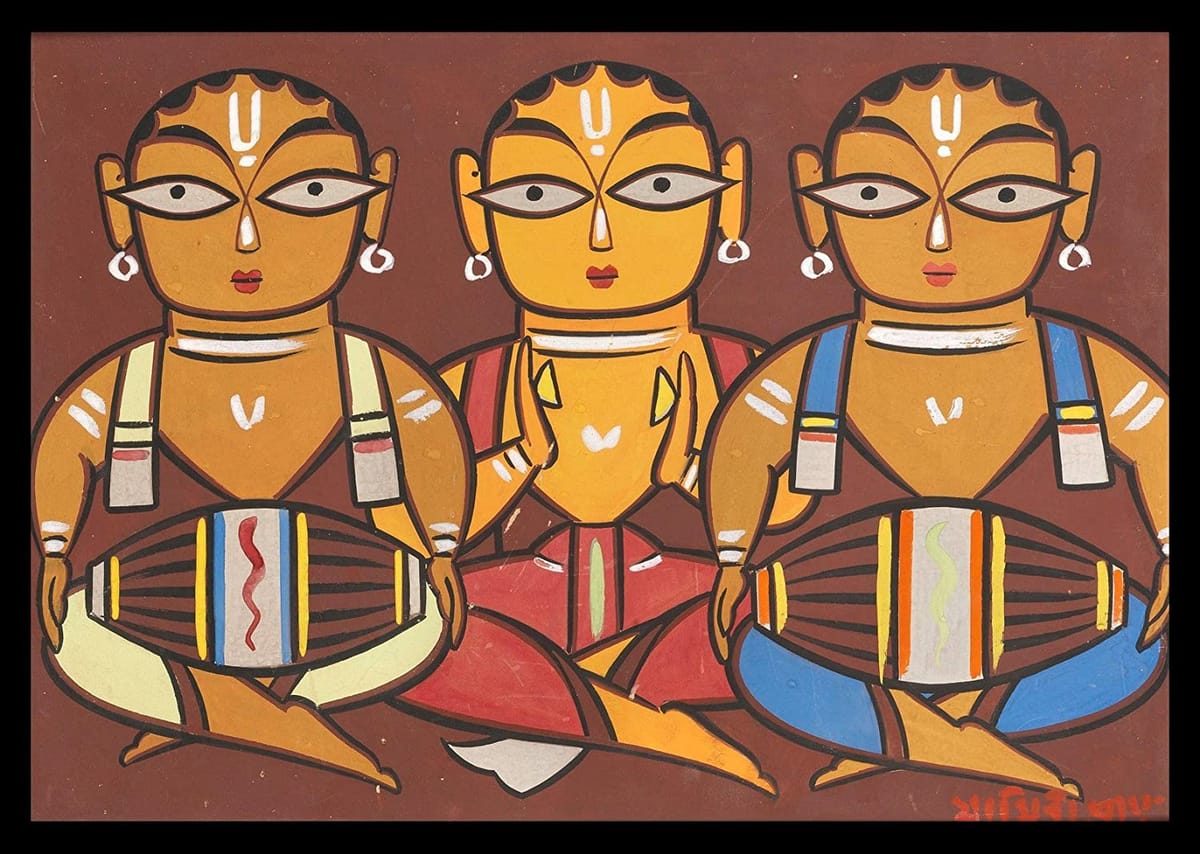The Three Emotional Constituents of Indian Classical Music: Sattva, Rajas and Tamas

I. The importance of the emotional content in Indian Classical Music
As any aficionado of this artistic tradition knows, the emotional factor is crucial to Indian classical music. So much so that it is often said in India that “if a performer fails to communicate emotionally with his/her audience, what he/she has played cannot be called music”. That is the importance of the emotional element for this musical tradition. Without it, the artistic phenomenon crumbles to such an extent that it even loses its name. Differently, the Western classical music world values and consider as historical landmark works music conceived basing on mathematical (Pierre Boulez), geometric (Iannis Xenakis) or aleatoric (John Cage) criteria and methods, to name just a few celebrated cases. This is music that shows a certain expressive capacity but also manifestly incapable of creating the necessary emotional stability and continuity in the listener (sthayibhava) to generate clear, intense and lasting emotional states (rasa). Such works, for the traditional Indian musical mentality, would be just arid and absurd products of an artistic mind corrupted by an excess of rationalism and which has lost sight of the true and deepest purpose of art.
II. Historical formation of the system of emotional categories in music
In the Sanskrit treatise Natyashastra, dated around the 2nd century A.D., we find categorized the different emotional states that the spectator can experience in front of the scenic work; which includes theater, dance and music. The eight types of aesthetic pleasure or rasa that Bharata explains about in his treatise are: erotic (shringara), comic (hasya), pathetic (karuna), furious (raudra), heroic (vira), terrible (bhayanaka), odious (bibhatsa) and marvellous (adbhuta).
A few centuries later, the Kashmiri theorist Abhinavagupta added to this list of eight rasas a ninth type, the so-called shanta rasa, peace. With this addition, the canonical navarasa theory is formed, the nine types of aesthetic pleasure that the spectator or listener can experience in front of the artistic work. This theory has maintained its relevance and usefulness, as a part of a general theory of art, for many centuries of history and up to the present day.
A tenth type of rasa or aesthetic pleasure that the Indian musical tradition has historically added to the list and to which it frequently appeals when speaking of the emotional flavor of the musical performance is bhakti, devotion.
Although other types of rasas have been argued and theoretically defended throughout the history, these ten we mentioned here (the navarasa plus bhakti) are the ones most frequently referred to in the context of Indian classical music (it is also true that some from the list proposed by Bharata -such as bhayanaka, hasya or bibhatsa– are rarely alluded to, in comparison with the rest).
III. Problems and contemporary proposals
In the 20th century, Indian musicology initiated an explicit debate on the relevance and consistency of these traditional emotional categories in relation to contemporary musical practice. There are several authors (it has also been the subject of discussion among those musicians concerned with providing theoretical coherence to their musical practice) who have critically assessed the convenience of continuing using those historical categories -we need to bear in mind that the original list of rasas proposed by Bharata is linked to the performing art as a whole, in which dance and dramatic narrative are more important than musical support- to classify the emotional potential of the ragas.
Of all these authors, two stand out for the depth of their knowledge of the subject and the audacity of their proposals: Vishnu Narayan Bhatkhande (1860-1936) and Prem Lata Sharma (1927-1998).
Bhatkhande, father of the modern Hindustani musicology and whose work marked a turning point in the theoretical and historical study of this artistic tradition, recognized that only four of the traditional rasas were relevant to the music of his time: erotic (shringara), pathetic (karuna), peace (shanta) and heroic (vira). His proposal, after studying a vast number of ragas and analyzing the emotional profile or profiles historically associated to them, was that the emotional identity of ragas depends to a large extent on the notes of their melodic scale. To give just one example and according to Bhatkhande’s observations; those ragas featuring the notes re komala (minor second) and dha komala (minor sixth) have historically been linked to the shringara and shanta rasas in a sufficiently frequent and consistent manner. On the contrary, ragas featuring other notes in their scale have been linked, establishing a certain theoretical tendency as well, to other types of rasa.
Professor Sharma was also of the opinion, in agreement with Bhatkhande, that the only four types of emotional flavors relevant to today’s music are shringara, karuna, shanta and vira. The other traditional types of rasas, she understood, are not relatable in a sufficiently clear way to musical art, she thought they are not musically expressible (they certainly are, however, in theater or dance). Moreover, Sharma thought that these four categories are emotional labels excessively specific for an art of such an abstract nature as music. Thus, her theoretical proposal was to classify the ragas and the different ways of rendering them using the concepts of madhurya guna, music of a soft and gentle character, and ojas guna, music of an energetic and dynamic character. Both categories would constitute the two extremes of an imaginary and indeterminately long line on which we could place each musical performance, placing it somewhere on that line depending on whether it is closer to the gentle and soft extreme or to the energetic and extroverted extreme. The professor from Punjab stated that the three classical shringara, karuna, shanta rasas would fall into the madhurya guna category and, on the other hand, vira rasa would fall into the ojas guna category.
IV. A proposal for a classificatory system based on Samkhya philosophy
As we can see, associating the different types of classical rasas to the current musical phenomenon in a sufficiently clear and consistent manner is problematic. On one hand, there is, as already mentioned, the difficulty of communicating, musically, traditional rasas such as bhayanaka, raudra, hasya or bibhatsa in a precise and differentiated way. On the other hand, it is also problematic to try to differentiate clearly and just with musical means rasas such as shanta and bhakti or vira and adbhuta, to give just two examples.
The present author, inspired by Pem Lata Sharma’s thoughts, would like to propose here a new way of understanding and classifying the emotional potential of Indian classical music ragas. This proposal implies incorporating into Indian music theory certain axial principles of the Samkhya system of thought, one of the sad-darshanas or the six Vedic/orthodox schools of classical Indian philosophy. Put very simply, this school of thought postulates that the world’s material dimension (prakriti) is composed of three constituents or qualities (tri-gunas). These three qualities, which under normal conditions are unbalanced and compose the material existence in unequal proportions, are; sattva, the stable and calm, rajas, the energetic and dynamic, and tamas, the heavy and confused. The three symbolic colors that the Upanishadic tradition links to these three gunas are white (sattva), red (rajas) and black (tamas).
The previously mentioned ten types of classical rasas could thus be reduced to these three emotional categories, avoiding this way the possible ambiguities and inconsistencies that the traditional system of emotional cataloguing of the ragas presents. The sattva guna would comprise the classical shanta and bhakti rasas, the most balanced and peaceful types of emotional pleasure. The tamas guna would correspond to the rasa karuna, characterized by its tendency to mournful longing and grief. And finally, the rajas guna would comprise the rest of the list, the rasas of rather vigorous and extroverted character; shringara, hasya, raudra, vira, bhayanaka, bibhatsa and adbhuta.
|
SATTVA Peace (shanta) and Devotion (bhakti) |
|
RAJAS Erotic (shringara), Comic (hasya), Furious (raudra), Heroic (vira), Terrible (bhayanaka), Odious (bibhatsa) and Marvellous (adbhuta) |
|
TAMAS Pathetic (karuna) |
The world of the ragas and their respective emotional identities could thus be classified in a more clear and methodical manner according to these aesthetic-spiritual concepts, taken from one of the oldest and most important philosophical systems of India, the Samkhya. Those ragas to whom tradition has associated rasas of calm and pondered character, such as Bhairav or Abhogi, would be sattvic. Those that have been linked to energetic and assertive emotional states, such as Marva or Durga, could be classified as rajasic. Finally, those ragas that historical practice has associated with emotional states such as sadness and decay, such as Bilaskhani Todi or Lalit, could be labeled as tamasic ragas. Of course, many ragas of the contemporary repertoire have a complex and nuanced emotional profile, and their emotional mood cannot be defined by appealing to just one of these three gunas or qualities, but rather to a combination – in unequal proportions – of them.
The musical performing styles could also be classified, in a very general way, according to these three principles or ontological qualities that the Samkhya philosophical system postulates. There are musicians whose personal style (regardless of the emotional identity of the raga they are playing/portraying) is characterized by sweetness and balance, both in the neatness of their melodic designs and also in the form/structure of their presentations. These are styles that could be adjectivized as sattvic. The style of other performers could be defined, differently, as energetic, categorical or extroverted. These styles could be understood as rajasic. Finally, a tamasic musical style would be one that presents the raga in a somewhat opaque manner, with a tendency to dejection, displaying a certain technical and formal vagueness. Obviously, the unequally strong presence of two or all three gunas in a single musical style is also possible (in fact, this is the most common case, generally speaking).
I conclude this article by reiterating the importance of the emotional factor in music and especially in the Indian musical tradition. To name it and organize it in a systematic way is to attempt to objectify the subjective and disparate feelings of a very large community of professionals and music lovers. Being such an important subject, it seems clear that it would be appropriate to continue to devote some attention to it, both musicians and musicologists. I sincerely hope the proposal I presented here may be of some interest to the reader.





